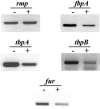The gonococcal Fur-regulated tbpA and tbpB genes are expressed during natural mucosal gonococcal infection
- PMID: 15972520
- PMCID: PMC1168583
- DOI: 10.1128/IAI.73.7.4281-4287.2005
The gonococcal Fur-regulated tbpA and tbpB genes are expressed during natural mucosal gonococcal infection
Abstract
Iron is limiting in the human host, and bacterial pathogens respond to this environment by regulating gene expression through the ferric uptake regulator protein (Fur). In vitro studies have demonstrated that Neisseria gonorrhoeae controls the expression of several critical genes through an iron- and Fur-mediated mechanism. While most in vitro experiments are designed to determine the response of N. gonorrhoeae to an exogenous iron concentration of zero, these organisms are unlikely to be exposed to such severe limitations of iron in vivo. To determine if N. gonorrhoeae expresses iron- and Fur-regulated genes in vivo during uncomplicated gonococcal infection, we examined gene expression profiles of specimens obtained from male subjects with urethral infections. RNA was isolated from urethral swab specimens and used as a template to amplify, by reverse transcriptase PCR (RT-PCR), gonococcal genes known to be regulated by iron and Fur (tbpA, tbpB, and fur). The constitutively expressed gonococcal rmp gene was used as a positive control. RT-PCR analysis indicated that gonorrhea-positive specimens where rmp expression was seen were also 93% (51/55) fbpA positive, 87% (48/55) tbpA positive, and 86% (14 of 16 tested) tbpB positive. In addition, we detected a fur transcript in 79% (37 of 47 tested) of positive specimens. We also measured increases in levels of immunoglobulin G antibody against TbpA (91%) and TbpB (73%) antigens in sera from infected male subjects compared to those in uninfected controls. A positive trend between tbpA gene expression and TbpA antibody levels in sera indicated a relationship between levels of gene expression and immune response in male subjects infected with gonorrhea for the first time. These results indicate that gonococcal iron- and Fur-regulated tbpA and tbpB genes are expressed in gonococcal infection and that male subjects with mucosal gonococcal infections exhibit antibodies to these proteins.
Figures





References
-
- Bonnah, R. A., R. Yu, and A. B. Schryvers. 1995. Biochemical analysis of lactoferrin receptors in the Neisseriaceae: identification of a second bacterial lactoferrin receptor protein. Microb. Pathog. 19:285-297. - PubMed
Publication types
MeSH terms
Substances
Grants and funding
LinkOut - more resources
Full Text Sources
Medical
Research Materials

